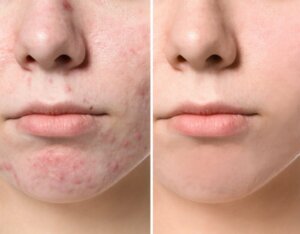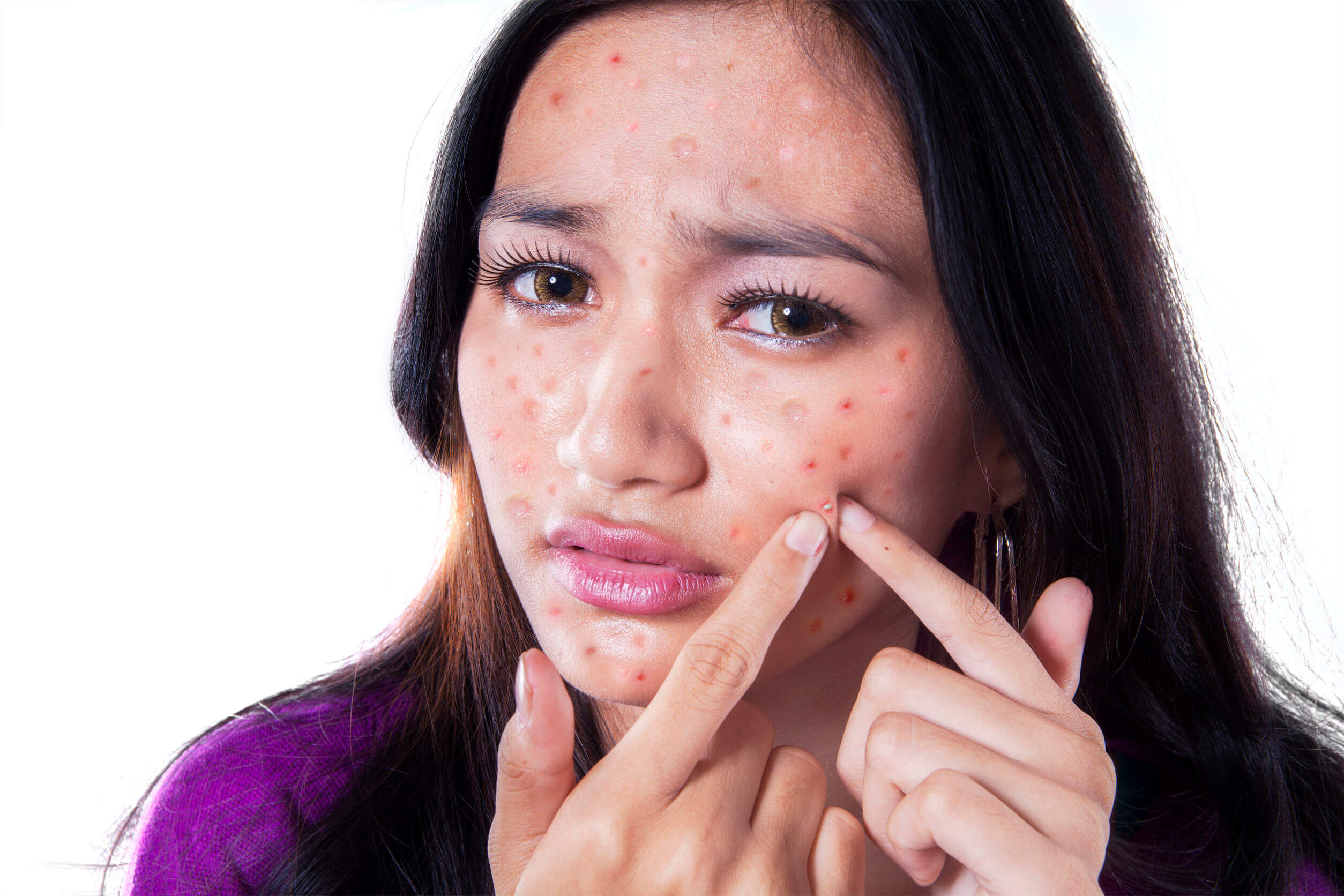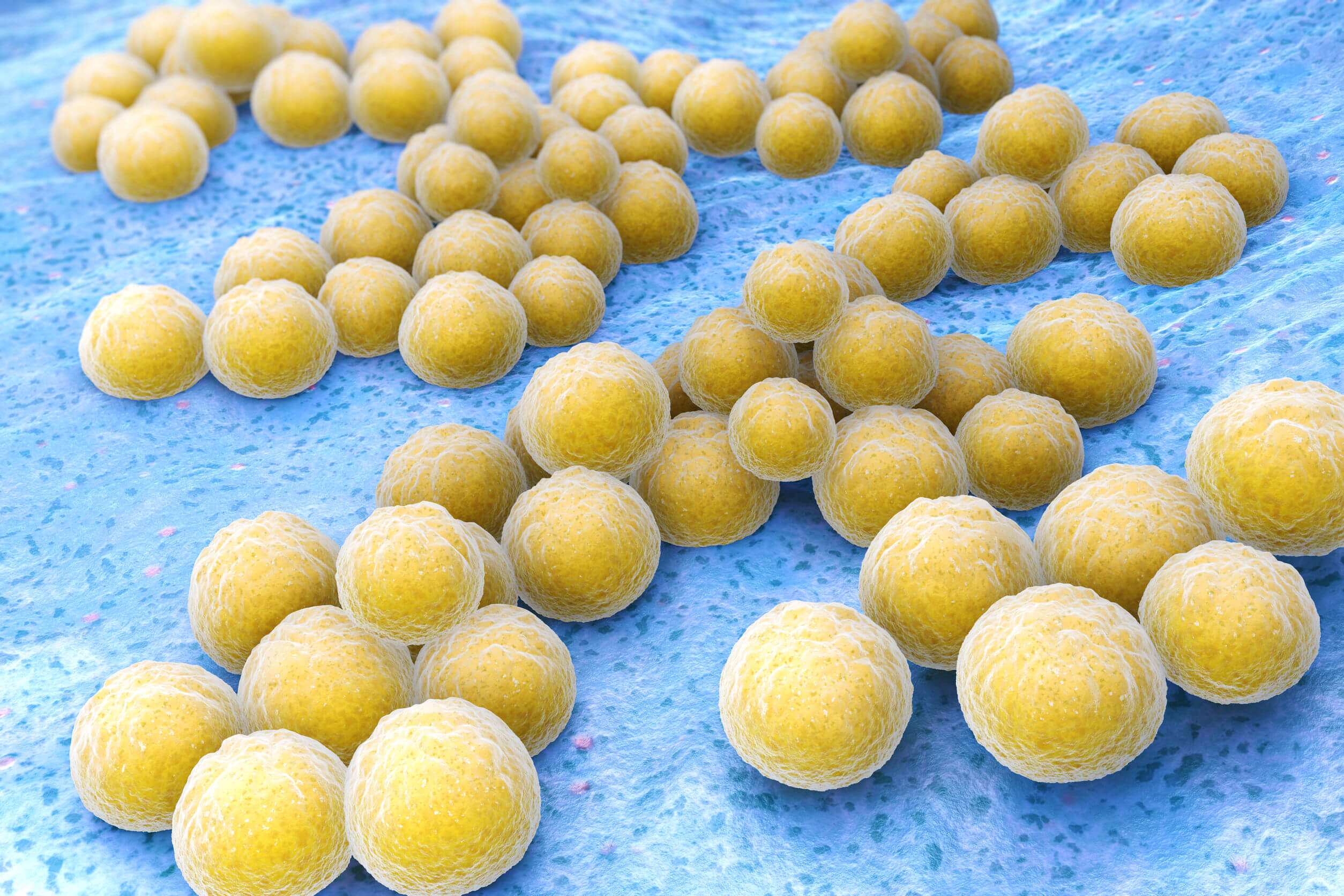6 Types of Pimples on the Face and How to Treat Them

Many people can’t distinguish between the different types of pimples that can appear on their faces, and they usually give the same treatment to all of them to try to get rid of them. However, most of the time the only thing they achieve is to worsen its appearance or damage the skin until scars are left.
Pimples, or spots, although annoying and a source of shame for some, are usually the reflection of some health condition. They are generally associated with hormonal changes, such as in adolescence or pregnancy. Issues as important as food also influence their appearance.
These lesions also usually appear in patients with specific conditions. For example, a study from East Carolina University revealed the relationship between some pimple-producing skin diseases and chronic kidney disease.
What are pimples on the face?
The term “pimple” is used to refer to any raised lesion on the skin. From a medical point of view, each of these lesions receive a specific name according to their appearance and mechanism of appearance.
These pimples can be the product of the obstruction of microscopic skin structures such as the pilosebaceous apparatus. In the case of an associated infection, there are usually signs of inflammation such as local redness and the presence of pus.
Acne is an example of a skin disease in which there are multiple pimples. In a patient with acne vulgaris, blackheads and pustules can be observed, which are some of the “pimples” that we will describe later.
The 6 types of pimples on the face and how to treat them
Now that it’s clear what they are and why they appear, we’re going to define the different types of pimples that can occur and how they can be treated without causing major effects. In any case, it is recommended to consult a dermatologist when you can see that the situation is getting out of control.
1. Blackheads
The most common blemishes of all, blackheads are caused by a blockage of the pores due to excess dead skin. There’s a false belief about its color as people often say it is due to the retention of dirt in the pores. Actually, this color appears due to the contact between the oil of the skin and the air.
They usually appear mostly on the nose, since a large amount of fat accumulates in this area.
How to treat them?
There are a number of ideal products to keep your face clean and prevent the accumulation of fat. Ideally, use one that corresponds to your skin type. As blackheads tend to take hold, a once-a-week facial peel will help.
Likewise, a study on acne indicates that extraction methods can also be used if the pores are very closed and prevent the removal of blackheads.
2. Red spots or papules

They are also common and they usually appear due to hormonal problems, consumption of foods high in carbohydrates, stress, anxiety, depression or insomnia.
These papules can be the result of the infection of the blackheads that, when inflamed, take this color and grow causing a little pain. To avoid further infection, it’s important to avoid touching the pimple or trying to pop it with dirty hands.
How to treat them?
One of the alternatives to treat red spots is to improve your diet and avoid the consumption of abundant carbohydrates. On the other hand, it’s important to keep your face clean, and you can use a mild product for this that doesn’t harm the surface of the skin, such as micellar water.
This product, according to the American Academy of Dermatology, doesn’t irritate sensitive skin due to its low level of non-ionic surfactant.
3. Whiteheads
Whiteheads appear due to the accumulation of fat and dead cells in the hair follicle, preventing it from opening.
As this material cannot be drained, the white pimples fill with pus and become inflamed due to bacterial action. This is when they can turn into pustules. At that time their appearance may change, with a red circle appearing around it.
How to treat them?
In case of an infection, the ideal option is the application of topical antimicrobials, always prescribed by the dermatologist. The use of soaps with a neutral pH or with specific characteristics for the patient’s skin type could also help to contain these types of pimples.
What you should never do is to pop the spots with your nails, hooks or items that are not for professional use.
4. Milium cysts
Milium cysts are small white or light yellow spots that are usually between 1 and 3 millimeters in diameter. They are produced by a build-up of keratin that clogs the pores. Unlike whiteheads, these lesions don’t hurt nor do they become infected.
They usually occur in the periocular area, that is, around the eyes. They also appear on the cheekbones, ears, and arms. There’s no specific cause that can explain its appearance, but among the possibilities are acne and overexposure to the sun.
How to treat them?
As in previous cases, it’s recommended not to touch the milium cysts or to try to squeeze them, as you’ll only get a wound and possible scars. The best treatment is to use products that promote skin respiration.
A superficial peel can be beneficial and avoid the use of greasy creams or very dense makeup. The skin should also be cared for with a sunscreen.
5. Cysts
We speak of cysts to refer to pimples or spots that accumulate fat inside the skin, and look like lumps that don’t always have an apparent exit point. They’re usually painful and feel hard to the touch.
Due to the complexity of the matter within, some inflammation may occur. In fact, there’s a type of acne that’s known as cystic or nodulocystic acne.
How to treat them?
In this case, it’s always ideal to check the treatment you should follow with a dermatologist. Topical antibiotics, benzoyl peroxide, or salicylic acid products are usually prescribed. Sometimes these injuries may require minor surgery.
6. Boils

They are usually very painful and generate pus, as they occur due to infection and inflammation of hair boils. On some occasions, the ingrown hair remains under the skin and therefore infection occurs, which may be due to the bacterium Staphylococcus aureus.
How to treat them?
Ideally, you should let there be natural drainage and to do this you can use hot compresses. Antibiotics are usually prescribed by the doctor.
Pimples on the face: tailored treatments
As we mentioned, there’s a specific way to treat each of the types of pimples, or spots, on the face, but the ideal option is to always consult a professional, thus avoiding damaging the skin, stimulating the proliferation of bacteria and increasing the amount of acne.
In the same way, it’s essential to know the type of skin you have so that you can use custom cleaning and care products, which could prevent your skin problem from getting worse.
Many people can’t distinguish between the different types of pimples that can appear on their faces, and they usually give the same treatment to all of them to try to get rid of them. However, most of the time the only thing they achieve is to worsen its appearance or damage the skin until scars are left.
Pimples, or spots, although annoying and a source of shame for some, are usually the reflection of some health condition. They are generally associated with hormonal changes, such as in adolescence or pregnancy. Issues as important as food also influence their appearance.
These lesions also usually appear in patients with specific conditions. For example, a study from East Carolina University revealed the relationship between some pimple-producing skin diseases and chronic kidney disease.
What are pimples on the face?
The term “pimple” is used to refer to any raised lesion on the skin. From a medical point of view, each of these lesions receive a specific name according to their appearance and mechanism of appearance.
These pimples can be the product of the obstruction of microscopic skin structures such as the pilosebaceous apparatus. In the case of an associated infection, there are usually signs of inflammation such as local redness and the presence of pus.
Acne is an example of a skin disease in which there are multiple pimples. In a patient with acne vulgaris, blackheads and pustules can be observed, which are some of the “pimples” that we will describe later.
The 6 types of pimples on the face and how to treat them
Now that it’s clear what they are and why they appear, we’re going to define the different types of pimples that can occur and how they can be treated without causing major effects. In any case, it is recommended to consult a dermatologist when you can see that the situation is getting out of control.
1. Blackheads
The most common blemishes of all, blackheads are caused by a blockage of the pores due to excess dead skin. There’s a false belief about its color as people often say it is due to the retention of dirt in the pores. Actually, this color appears due to the contact between the oil of the skin and the air.
They usually appear mostly on the nose, since a large amount of fat accumulates in this area.
How to treat them?
There are a number of ideal products to keep your face clean and prevent the accumulation of fat. Ideally, use one that corresponds to your skin type. As blackheads tend to take hold, a once-a-week facial peel will help.
Likewise, a study on acne indicates that extraction methods can also be used if the pores are very closed and prevent the removal of blackheads.
2. Red spots or papules

They are also common and they usually appear due to hormonal problems, consumption of foods high in carbohydrates, stress, anxiety, depression or insomnia.
These papules can be the result of the infection of the blackheads that, when inflamed, take this color and grow causing a little pain. To avoid further infection, it’s important to avoid touching the pimple or trying to pop it with dirty hands.
How to treat them?
One of the alternatives to treat red spots is to improve your diet and avoid the consumption of abundant carbohydrates. On the other hand, it’s important to keep your face clean, and you can use a mild product for this that doesn’t harm the surface of the skin, such as micellar water.
This product, according to the American Academy of Dermatology, doesn’t irritate sensitive skin due to its low level of non-ionic surfactant.
3. Whiteheads
Whiteheads appear due to the accumulation of fat and dead cells in the hair follicle, preventing it from opening.
As this material cannot be drained, the white pimples fill with pus and become inflamed due to bacterial action. This is when they can turn into pustules. At that time their appearance may change, with a red circle appearing around it.
How to treat them?
In case of an infection, the ideal option is the application of topical antimicrobials, always prescribed by the dermatologist. The use of soaps with a neutral pH or with specific characteristics for the patient’s skin type could also help to contain these types of pimples.
What you should never do is to pop the spots with your nails, hooks or items that are not for professional use.
4. Milium cysts
Milium cysts are small white or light yellow spots that are usually between 1 and 3 millimeters in diameter. They are produced by a build-up of keratin that clogs the pores. Unlike whiteheads, these lesions don’t hurt nor do they become infected.
They usually occur in the periocular area, that is, around the eyes. They also appear on the cheekbones, ears, and arms. There’s no specific cause that can explain its appearance, but among the possibilities are acne and overexposure to the sun.
How to treat them?
As in previous cases, it’s recommended not to touch the milium cysts or to try to squeeze them, as you’ll only get a wound and possible scars. The best treatment is to use products that promote skin respiration.
A superficial peel can be beneficial and avoid the use of greasy creams or very dense makeup. The skin should also be cared for with a sunscreen.
5. Cysts
We speak of cysts to refer to pimples or spots that accumulate fat inside the skin, and look like lumps that don’t always have an apparent exit point. They’re usually painful and feel hard to the touch.
Due to the complexity of the matter within, some inflammation may occur. In fact, there’s a type of acne that’s known as cystic or nodulocystic acne.
How to treat them?
In this case, it’s always ideal to check the treatment you should follow with a dermatologist. Topical antibiotics, benzoyl peroxide, or salicylic acid products are usually prescribed. Sometimes these injuries may require minor surgery.
6. Boils

They are usually very painful and generate pus, as they occur due to infection and inflammation of hair boils. On some occasions, the ingrown hair remains under the skin and therefore infection occurs, which may be due to the bacterium Staphylococcus aureus.
How to treat them?
Ideally, you should let there be natural drainage and to do this you can use hot compresses. Antibiotics are usually prescribed by the doctor.
Pimples on the face: tailored treatments
As we mentioned, there’s a specific way to treat each of the types of pimples, or spots, on the face, but the ideal option is to always consult a professional, thus avoiding damaging the skin, stimulating the proliferation of bacteria and increasing the amount of acne.
In the same way, it’s essential to know the type of skin you have so that you can use custom cleaning and care products, which could prevent your skin problem from getting worse.
- Gagnon1, A. L., & Desai, T. (2013). Dermatological diseases in patients with chronic kidney disease. Journal of nephropathology, 2(2), 104–109. https://doi.org/10.12860/JNP.2013.17
- Ramçon Bonet. El acné: qué es y cómo combatirlo. Offarm. Vol. 21. Núm. 8. Pág. 92-100. Disponible en: https://www.elsevier.es/es-revista-offarm-4-articulo-el-acne-que-es-como-13035869
- Manuel Palomino Yamamoto. Estrctura de la piel. Revista Peruana de Dermatología. Vol. 11. Núme 2, 2001. Disponible en: https://sisbib.unmsm.edu.pe/BVRevistas/dermatologia/v11_n2/fisio_piel.htm
- M. José Muñoz. El acné y su tratamiento. Offarm. Vol. 20. Núm. 8. Pág. 71-71. 2001. Disponible en: https://www.elsevier.es/es-revista-offarm-4-articulo-el-acne-su-tratamiento-13018369
- Leonardo Sánchez-Saldaña, Eliana Sáenz-Anduaga. Infecciones cutáneas bacterianas. Dermatología Peruana 2006; Vol 16(1). Disponible en: https://sisbib.unmsm.edu.pe/BVRevistas/dermatologia/v16_n1/pdf/a02.pdf
- Aluma Tenorio MS, Arango Álvarez LM, Jiménez Calfat G, Restrepo Molina R, Mejía Zapata PA. Milium Coloide. rev. asoc. colomb. dermatol. cir. dematol. [Internet]. 1 de octubre de 2002 [citado 11 de enero de 2021];10(3):945-8. Disponible en: https://revista.asocolderma.org.co/index.php/asocolderma/article/view/708
- Aurora Guerra Tapia, Raúl de Lucas Laguna, José Carlos Moreno Giménez, Montserrat Pérez López, Miquel Ribera Pibernat, Elena Martínez Prats, Rosa Senan Sanz, José Casas Rivero. Consenso en el tratamiento tópico del acné. Med Cutan Iber Lat Am 2015; 43 (2): 104-121. Disponible en: https://www.medigraphic.com/pdfs/cutanea/mc-2015/mc152d.pdf
- Juan Carlos Sánchez. Revisión bibliográfica forunculosis. Revista Médica de Costa Rica y Centroamérica LXX (608). 569-571, 2013. Disponible en: https://www.medigraphic.com/pdfs/revmedcoscen/rmc-2013/rmc134c.pdf
- Lipoma. Mayo Clinic.
Este texto se ofrece únicamente con propósitos informativos y no reemplaza la consulta con un profesional. Ante dudas, consulta a tu especialista.







